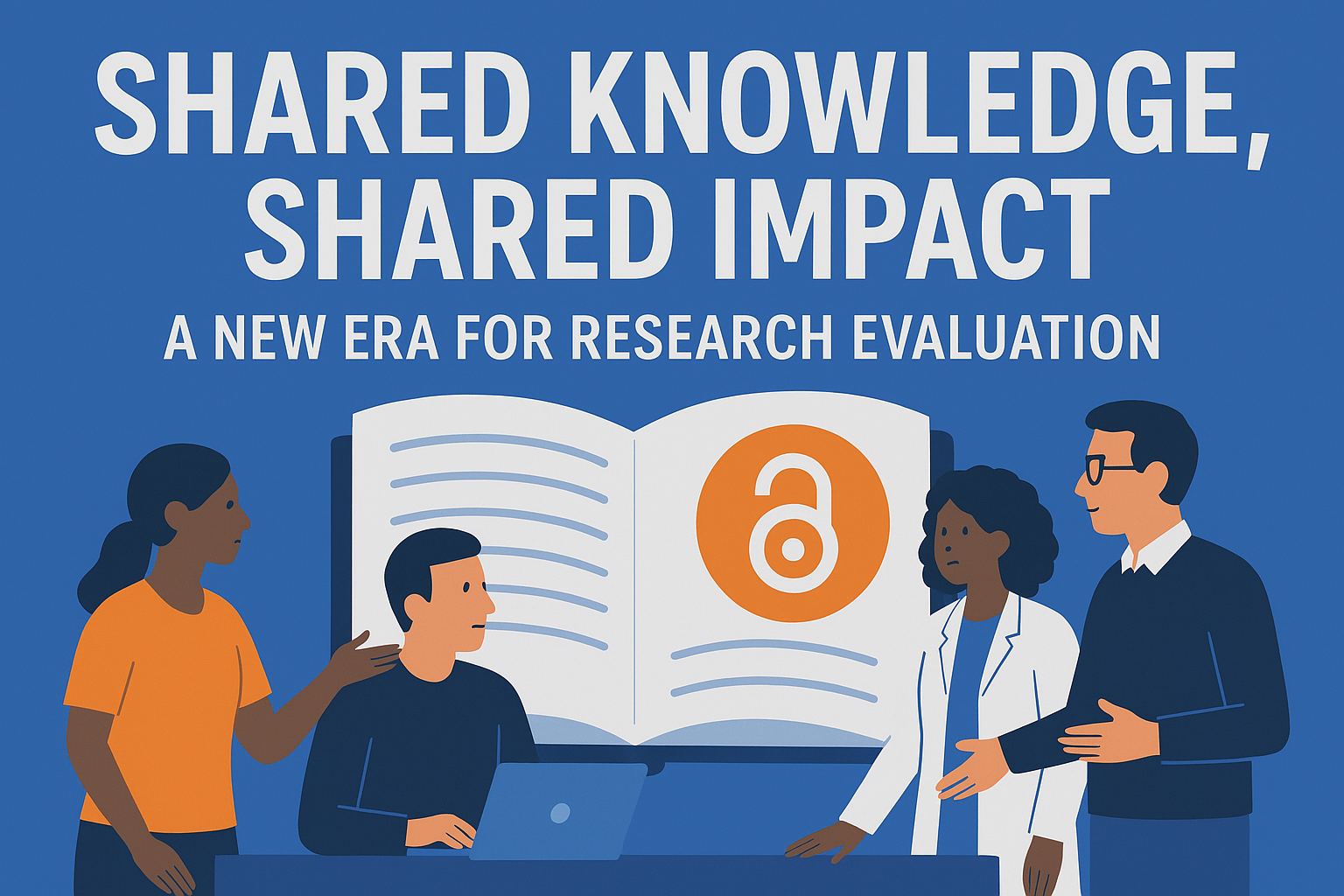Shared Knowledge, Shared Impact: A New Era for Research Evaluation

As the research world becomes increasingly interconnected, the way we measure scientific success is undergoing a quiet transformation. The Open Access Week 2025 theme: “Who Owns Our Knowledge?”, urges us to think critically about not just data ownership, but also the ownership of impact. Are we still defining success through journal metrics alone, or are we beginning to value how research informs practice, policy, and public good? In this collaborative article, thought leaders from across the scholarly ecosystem reflect on what it means to move from journal impact to community impact, and how open, equitable research practices can help redefine the very notion of success in science. We share the insightful perspectives of:
Duncan Nicholas (Development Editor of Reproductive Biomedicine Online / Past-President of EASE)
Iva Grabarić Andonovski (Editor of Food Technology and Biotechnology journal, EASE Vice President, EASE Croatian Chapter chair)
Christopher Leonard (Director of Product Solutions, Cactus Communications)
Rachel Martin (Global Director Sustainability at Elsevier)
What does community impact mean and how should we measure it?
Duncan Nicholas – There are several different communities around individual researchers, journals, societies, or research fields that one could differentiate between. Dividing into themes helps focus on understanding what ‘Impact’ may look like for each of the groups and help you manage the ways you work towards engaging them, understanding their needs, and the messages and techniques you use to promote your work to them. I like to consider perspectives such as – journals as community hubs, peer review as a community engagement and education activity, broader society activity and outreach and science communication.
For authors looking at journals and formal publication – who is accepting your work (you can include citations in here).
For journals – citations work here as well, but beyond that, “impact” could be receiving papers from authors you would like (to be) publishing in your desired specialist topics and getting the most interesting papers and recruiting new reviewers; working at improving qualities of reviews; measuring author or reader opinions through feedback; and libraries, faculty, educationalists stocking/indexing/listing your work.
For both individual authors and journals, several other measures of impact can be getting research various types of attention and application, such as:
General public – is anyone engaging with your work? How are you reaching them with it?
Journalists, bloggers, vloggers, podcasts etc – how much your work appears in the media, and in what ways? Is it helping reach more of the public? Or other targets?
Government agencies – are you effecting policy change?
Schools and teachers – is your work being incorporated into educational settings?
Funders – are you winning grants or gaining sponsorship and financial support?
Public speaking – giving talks at conferences, or public events
These can all further the impact of the work by having their own levels of influence and investment into a project, and it is those further actions, or ripples, that really help define these communities and demonstrate how they are of value to you.
Iva Grabarić Andonovski – The community impact of the research cannot be measured by journal impact, but rather by its value for the community, within the context of the field. For example, in food science, the impact on the community could be demonstrated by the development of a novel functional product that can be produced on a large scale and at minimum costs. Such an innovation could provide access to nutritious food that has a positive impact on human health. This type of impact aligns with several Sustainable Development Goals (SDGs), such as Zero hunger (SDG2), Good health and well-being (SDG3), Industry, innovation and infrastructure (SDG9), and Responsible consumption and production (SDG12), all of which offer tangible ways to measure broader societal benefits.
Christopher Leonard – Community impact means research that creates real-world change—influencing policy, improving health outcomes, or addressing local needs—rather than just generating academic citations. We should measure it through qualitative evidence like policy changes and stakeholder testimonials, not just journal impact factors. The key is collecting multiple forms of evidence throughout the research process, recognizing that meaningful change often takes years to unfold and requires looking beyond traditional bibliometrics.
Often a large change in a marginalized community can have greater effects than a marginal change in a large community, but that is difficult to recognize.
Rachel Martin – It is important to consider that the very concept of “impact” and thus what we as a community deem to be a “success” is subjective. What benefits one group may not be seen the same way by another. For example, a new technology might bring jobs and infrastructure to some parts of a community, while causing displacement or cultural loss for others. We should recognize that our values, priorities, and lived experience shape how we perceive outcomes. As a result, community impact, from my perspective, requires a multi-faceted approach recognizing that success looks different and should be measured differently across communities.
Research evaluation is already moving beyond traditional metrics like journal impact factors to embrace a broader, more holistic understanding of impact. We see newer metrics looking at citations of research in documents such as policy and patents and even mentions on social media to measure broader “impacts”.
However, we must remember that communicating impact requires more than just analyzing data proxies. It’s equally important to consider how researchers convey the story of their impact—to secure funding, accelerate scaling, and drive real-world implementation. Impact resonates beyond academic audiences, and frameworks like the SDGs provide a common, accessible language that helps stakeholders immediately understand how research aligns with societal priorities.
Roohi Ghosh – I believe that community impact in research means that the research needs to benefit not just academia, but society at large. Has the loop of research come a full circle: from addressing the challenges that the community faces to lab to policy and back to the community. This, in one line, is community impact according to me.
It’s not enough to just change the way impact is looked at. True change will happen only if career advancement, promotions and more are all connected to community impact and not journal impact factors. What we really need to do is ask ourselves some tough questions:
- Has my research informed public policy, local practice, or community awareness?
- Has my research been translated, visualized, and shared in a way that it is accessible beyond paywalls?
- Has my research inspired collaboration or trust between other researchers and the communities that they study?
I feel that true community impact should be measured in uptake, access, and influence, that is, can people use my research in real life, can they access it easily without barriers and can it empower people to apply it, or adapt it to make decisions that affect their lives.
What changes are needed to value community impact in academia?
Duncan Nicholas – My short answer is, a demonstration of the informative value of any other form of assessment measurement, combined with a reduction in frequencies of individual assessment and the competitive nature of the business of academia. The main reason institutions seem to give for reliance on simple short-cut metrics, is to cope with the volume of assessment that needs to take place; any deeper review of the work would be more time-consuming than is feasible. Alongside this, the attractive problem with the use of traditional metrics – by which we primarily mean impact factor, possibly H-Index, and grant funding – is that they are simple and somewhat effective at communicating a value that does have some proven cultural (academic, etc.) weight.
This is a situation with a hold that is hard to break.
It is easy to say a systemic change from ‘quantity to quality’ would address the problem, but there already are many scholars around the world producing a not-excessive amount of very high-quality, focused work, and there are a range of outputs and impacts evaluated. There are also so many situational factors and scenarios that it would be easy to say there is no ‘one size fits all’ approach to meetings the range of needs. Many initiatives have been trailed over the years to expand on the measures that have value, such as the Snowball Metrics of British universities and the UK REF’s repeated intentions to reduce reliance on metrics, so I do not feel that research assessment has been static or lacking in this goal for any period of time since I can remember.
Iva Grabarić Andonovski – Both authors and journal editors should give more consideration to how they provide information to the broader community. Authors could discuss the potential community impact of their findings when offering a future perspective. Editors might consider including a lay summary, an industry summary (where applicable), or a summary for policymakers alongside the published manuscript. Researchers must find a way to communicate not only with their peers but also with the wider community.
Christopher Leonard – The tenure system must recognize community-engaged scholarship as equivalent to traditional research, not marginal “service work.” We need promotion committees trained to evaluate impact beyond citations and funding structures that reward genuine community partnerships from the start. The deeper challenge is that universities are judged by prestige flowing from traditional metrics. Until university rankings and research assessment exercises incorporate community engagement meaningfully, individual researchers prioritizing community impact often sacrifice career advancement.
We also need new publication venues altogether—community-accessible formats, multilingual dissemination, open-access repositories specifically for practice-oriented research. Academic publishing’s paywall problem is fundamentally at odds with community impact.
Roohi Ghosh – Today, researchers still focus mainly on publishing in top journals. Yes, we celebrate what’s new, but do we always celebrate what’s useful even if it isn’t published in a top journal? For community impact to be measured, the first step is to acknowledge the efforts of researchers who share their findings openly, explain their work to the public, and/or co-create solutions with local communities. Of course, for this to happen, funders and universities need to start rewarding things like open data, research summaries in local languages, or partnerships with schools, hospitals, or NGOs. These are real signs that research is reaching people and making an actual difference.
Rachel Martin – To value community impact alongside traditional metrics, academia and publishing need a cultural shift toward the principles of a 4th Generation University—an institution that has evolved beyond its traditional focus on education (1st generation), research (2nd generation), and innovation or entrepreneurship (3rd generation). A 4th Generation University is mission-led and societally engaged: it seeks not only to generate and disseminate knowledge but to apply it collaboratively to address real-world challenges such as sustainability, equity, and resilience.
This evolution requires structural changes that recognize community partnerships, co-created research, and measurable social outcomes as core indicators of success. Culturally, it means valuing reciprocity, local knowledge, and collective problem-solving as much as academic prestige.
What are your thoughts on “who owns our data and our impact?”
Duncan Nicholas – I don’t think anyone owns any impacts, as these are actions, reactions and responses to work.
Ownership of data is somewhat different. From the research data you might collect, ownership depends on many things such as contractual or professional position and relationship to the work, personal information included in the data. Then beyond ownership, who has rights or permissions, of access and reuse, and what that data can be used for. These can all be stipulated in contractual agreements prior to data collection, and licensing arrangements after publication – often the two relate to each other.
Outside of specific research projects, navigating the world, ownership of data and digital activity is something to be very conscious and wary of. Social media companies claiming these materials has been an issue for some time. Now, the big issue is of course AI, and people uploading works, texts, their own or other people’s images to tech companies that will be reused in various disclosed or undisclosed ways. Reading the small print, and deciding for yourself what values you will uphold, how much integrity you maintain, what you will compromise and are prepared to give to these companies, or what your contractual stipulations will permit, is really very important.
Iva Grabarić Andonovski – I would say that the funders own our data. If the research is a result of the publicly funded project, then the resulting data should be considered a public good – owned by the community. Therefore, Open Access is a way of providing feedback to the community about how public funds have been used. Community engagement and citizen science initiatives are increasingly encouraged within the European Union, as research should ultimately aim to improve the quality of life. To do this efficiently, we must listen to the community feedback, to understand which areas need the most attention and improvement.
Christopher Leonard – Research often extracts data from communities while researchers claim ownership of both the data and resulting “impact” for their careers. This creates a fundamental power imbalance. Communities should have sovereignty over data about themselves—controlling how it’s collected, used, and shared, following models like Indigenous OCAP principles. When community members co-design research and interpret findings, they should be recognized as co-creators of impact, not just subjects. True equity requires shared decision-making power, resources, and credit—not just acknowledging communities in papers. However, academia’s incentive structure – focusing on individual recognition -fundamentally conflicts with genuine co-ownership.
Rachel Martin – Technologically, open science, digital collaboration, and participatory platforms can help bridge academia and society. Ultimately, excellence must be redefined—not just by what universities publish, but by the positive difference they make in people’s lives.
Roohi Ghosh – Technology can play a part in connecting research to real-world results, for example, can we start tracking if a paper was instrumental in influencing policy, used in a local project, or changed how something was done in practice? In the end, measuring community impact is not about letting a few decide what counts as success, but instead the community needs to decide what they could use, access, and trust.









